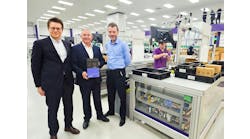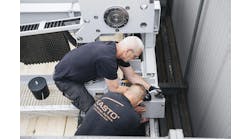When your industrial motor requirements move beyond a single-speed application to a variable-speed application with adjustable acceleration and deceleration, and possibly precision position or torque control, the motor and drive need to team up for a winning solution.
The motor drives connect to and provide enhanced operation to dozens of different types of motors. These include dc, ac, stepper and servo motors. There are definitions to be found online along with the advantages and disadvantages of each type of motor. However, a big thing to keep in mind is that many of the motors are designed for a specific application or their applications are limited.
There are also many characteristics to know when it comes to motor selection. This includes things such as when a dc motor’s speed is high, its torque is low and vise versa. Another characteristic is that running an ac motor slower using a variable frequency drive (VFD) is a common way to save energy when operating fans, pumps or similar devices. Another is that the stepper motor typically has maximum torque at zero speed, and the servo motor is known for its dynamic speed control and precision position and torque control.
Fortunately today automation vendors have a wide selection of motors and drives for just about any application. If you need a motor and drive, get with a local industrial distributor or motor manufacturer. Leveraging their knowledge is often the best option.
Add the drive
With the motor selected, a matching drive is often required. All drives typically allow adjustment of minimum and maximum speed, current (torque) limit and acceleration and deceleration time.
In addition to these adjustments, the dc drive converts ac power to dc power and regulates the armature current and voltage to control the torque and speed of the dc motor. The nonregenerative dc drive operates the motor in one direction only and requires reversing the armature leads to change motor direction. The regenerative dc drive can reverse the motor internally and provide a regenerative breaking function. This is important in applications that start and stop or change directions often.
The ac drive also converts ac power to dc power but then inverts it back to a controlled voltage and frequency that is output to the ac motor. The pulse width modulated (PWM) drive is the most common ac drive and most popular of all drives. It works well for most industrial applications due to its performance, simple design and low cost. It converts the ac source to dc and then inverts the dc to an approximation of a sine wave at the desired Volts/frequency ratio. These PWM ac drives operate common three-phase ac induction motors for a low-maintenance and low-cost design.
A higher-performance ac drive is a vector drive. It also uses PWM but can individually control the motor speed and torque. Encoders can be added to ac drives closing the loop for improved speed regulation. Adding an encoder to a vector drive enables 100% or more of the rated ac motor torque to be available at zero speed, which is desirable when holding a load in a crane application.
The most dynamic and precise motor and drive applications include the stepper and servo motor paired with the appropriate drive. The stepper motor and drive provide precise position or speed control modes whether open or closed loop. The closed-loop servo motor and drive add a torque control mode.
While most drives are controlled using analog, step and direction signals or the drives built-in indexer function, many drives now offer various communication methods. Some only offer configuration and monitoring via this communication link; other drives provide real-time control, coordinated motion and safety functions integrated with the controller.
RELATED: How to select a variable frequency drive
Which motor do you use, and how do you size it? That may be a question beyond the basics, but before you contact the vendor, be sure to have some application information available.
The vendor will need to know about the application and will ask for speed, torque and inertia information. You'll need to know how fast you want to run the system. The inertia needed can be difficult to calculate and requires rotational mass and radius measurements, gearbox information and mechanical linkage configuration. The vendor is going to ask lots of questions and then use a software package to calculate the inertia. Other variables may include load, duty cycle, environment and positional accuracy requirements.
The speed, torque and inertia are important, but a defined motion profile is, as well. If a motor application must run a wide range of speeds with a varying load, what motor would work best? If you can provide the application engineer the motion profile information, you may find that an ac induction motor is not the best option, since a permanent magnet dc motor can be more efficient over a wide range of speeds and loads.
How complex is your motor and drive application? Are you an OEM where cost matters most or possibly a custom machine builder where high performance is king? In either case, you will need to study up on the basics because there are many motors and drives available. And get with you motor or motion-control vendors during the motor and drive selection process. They will help find the best technology, motor and drive for the application and address requirements such as motor efficiency, safety, performance and cost.






